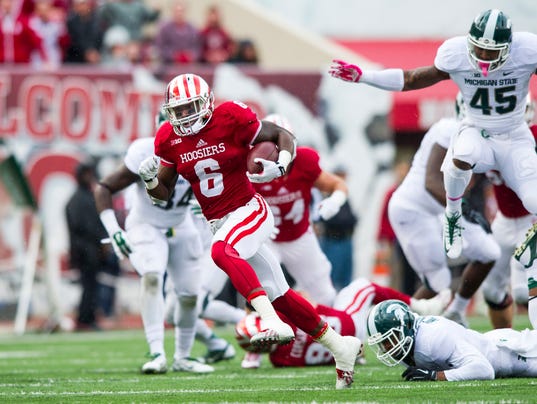It’s no secret that the Falcons needed a running back. With the departure of Steven Jackson and Jacquizz Rodgers, the team entered the draft with only 2014 4th round pick Devonta Freeman and deep threat receiving back Antone Smith in the fold. Rather than pursue the two big name first round backs, Atlanta waited until the 3rd round to address the need, picking up Indiana RB Tevin Coleman.
Coleman was a prolific college runner, racking up 3602 offensive yards despite seeing at least 10 touches in only 22 games. In 2014, as a junior, he picked up 2036 yards and 15 TD, ran for over 300 against Rutgers, and finished 7th in the Heisman vote. So how does an elite college back drop to the 3rd round and wind up the 5th back off the board?
One knock on Coleman is his size, at just 206 lbs. A common complaint among scouts is that he too often runs with the ball in the wrong hand, which could have been a contributing factor in his fumbling the ball four times last season, losing three. He isn’t particularly creative or deceptive; he often stares at his hole from the snap, and he’ll run to it even if a LB is on his way to plug it. With Coleman there’s not often that moment in the backfield where it’s not obvious what he’s going to do. You see that with some backs, where they’re looking straight ahead, and then boom – they cut and they’re off. Coleman is a bullet train on a track, and it’s comparatively easy to see the track.

The thing is, even when you know he’s getting the ball and where he’s going with it, he’s still hard to catch and bring down. Coleman is really fast, with a 4.39 40 that ranks in the 93rd percentile just among running back prospects, and really elusive. Let me spend some time stressing both.
First, the speed. Several years ago, Bill Barnwell of Football Outsiders noticed something. 40 times weren’t very predictive of future success, around 29% correlation, partially because they didn’t account for the size of the player running it. If two players each run a 4.50 40 yard dash, and one is 200 lbs while the other is 225, the larger player had the vastly more impressive drill. Barnwell created a metric called Speed Score which he found to be more predictive of future success, at around 45-50% correlation. Granted, that’s still not a strong correlation, but that speaks to something I think we all know deep down – running backs are volatile and unpredictable at the next level, not to mention fragile with a short lifespan. 45% seems pretty good to me. Speed Score was defined as (Weight * 200) / (40 time^4). Simple, everyone can calculate it, and it revolves around an average score of 100. Over 100 good, under 100 bad. Tevin Coleman, at 206 lbs with a 40 time of 4.39 seconds, comes in with an impressive Speed Score of 110.92. A list of guys over 110 has plenty of big names: Adrian Peterson, Chris Johnson, Le’Veon Bell, Doug Martin, CJ Spiller, Ryan Matthews, etc. Last year’s 110+ club member was Jerick McKinnon, who finished 8th in the league in yards per carry at 4.8. Simply put, there is success associated with this combination of power and speed, and Coleman, despite his frame, is in the club.
Next, the elusiveness. Pro Football Focus’ 2014 project where they graded every FBS snap of the season, appropriately called College Football Focus, recently released the collegiate versions of some of their popular RB metrics. They ranked Coleman as the 7th most elusive back in the nation last year, ahead of the higher drafted Ameer Abdullah and TJ Yeldon. Coleman showed off that previously discussed combo of power and speed in different ways. He averaged 4.03 yards per carry after contact, leading the country. That’s right, better than Todd Gurley (3.93) and Melvin Gordon (3.58). Now, I should note that Coleman racked up more of these yards against lesser competition, beating up on Indiana State, Bowling Green, and North Texas, but he also ran for 228 and 3 TD against Ohio State, so I’m not sure there’s too much we need to dock him for. Besides, it’s not like he had a legion of next-level prospects surrounding him at Indiana. Coleman forced a missed tackle on 18% of his touches. That’s good, but it pales in comparison to Todd Gurley (29.6%) and trails Melvin Gordon (21.5%) as well. Coleman isn’t the prospect those two are, but he’s not particularly far behind, either.
Another noteworthy statistic from the CFF project points to Coleman’s pure speed. 57% of Coleman’s yards came on running plays of over 15 yards, the highest percentage in the country. In fact, Coleman had over 1100 yards alone on such plays. When Coleman broke free, he picked up very big chunks of yardage. And he broke free often.
Finally, just because Mockdraftable.com has these really cool spider graphs, I figure I’ll post them in each player write-up. It’s a nice visualization of the athletic measurables for each player. Here is Coleman’s:
As you can see, it’s a big mix of speed and power (his bench results were strong), mixed with small body measurables (height, weight, hand size). Also, check out the next tab for specific results and a list of the most comparable players. Lamar Miller is another former Speed Score champion, and Carnell Williams had NFL success.
Scouting services seemed pretty split on Coleman. Joe Marino of Draft Breakdown had a 3rd round grade on him, as did Corey Chavous‘ Draftnasty. NFL.com and NFL Draft Scout considered him a 2nd round pick. Pro Football Now (formerly Pro Football Weekly) had Coleman as the #1 back in the entire draft. Either way, nearly no source thought Coleman should last past the 3rd round, making it very hard to disagree with the Falcons’ selection.
Coleman fits into the Falcons depth chart nicely, right ahead of Devonta Freeman, in my opinion. They should rotate pretty heavily, both seeing comparable amounts of carries. He’s probably not a workhorse that can carry the team on his back for 25 carries a game, but he is an offensive weapon with a nice mix of strength and elusiveness that should be a day 1 starter, making it the third straight round in which Dan Quinn found a starter. Not bad at all.
Projected longterm role: Starting RB/#2 with carries
Projected 2015 role: Starting RB




Leave a Reply